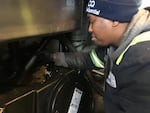UPDATE (Monday, May 6, 9:24 a.m. PT) – A rooftop vent creaks open inside a warm, humid greenhouse at Woodburn Nursery and Azaleas. It's controlled by a computer that helps owner Tom Fessler reduce his natural gas bills.
The greenhouses covering 100 acres of his farm are filled with potted plants he’ll soon be selling to home and garden stores, and natural gas helps keep those plants alive when it's cold outside.

Woodburn Nursery and Azaleas owner Tom Fessler has 100 acres of greenhouses at his Oregon farm.
Cassandra Profita / OPB
“Natural gas is really the only source of heat that we have,” he said. "Energy costs us a lot of money. Aside from labor, it's our next highest cost, so we have to be as efficient as we can."
Fessler has upgraded his greenhouses and changed the way he grows plants to reduce his natural gas use, but he’s worried all that might not be enough to keep his business going if Oregon’s cap-and-trade bill goes forward as proposed.
Oregon’s biggest natural gas utility, Northwest Natural, projects House Bill 2020 would raise prices for industrial customers like Fessler by 28% in the first year of the program.
“That’s a couple hundred thousand dollars to our bottom line," he said. "We can’t increase our prices to offset that. It's going to force us to make some tough decisions moving forward."
The Bigger Greenhouse Problem
Oregon lawmakers are trying to tackle bigger greenhouse problem. Their goal is to reduce the greenhouse gas emissions that are heating up the planet.
Their plan would limit carbon emissions from the state's largest polluters and charge them for every ton of carbon they emit. The state would raise revenue by selling pollution permits and then invest that money in clean energy and transportation projects that further reduce the state's carbon emissions. Over time, the limit on carbon emissions would come down — to 45% below 1990 levels by 2035 and 80% below 1990 levels by 2050.

The city of Portland's Columbia Boulevard Wastewater Treatment Plant burns some of the extra methane produced in its sewage treatment process.
Cassandra Profita / OPB
As the program progresses, fewer pollution permits would be available and polluters would have to either reduce their emissions or pay more for their emissions. The cap on carbon emissions would cover about 100 companies, including fuel suppliers, utilities and manufacturers. But critics of the bill warn the effects of that cap could mean higher prices for everyone who uses fossil fuels and the products that rely on them.
Though some have disputed their numbers as misleading, Northwest Natural has also projected an 11% jump in natural gas prices for its residential customers in the first year of the proposed cap-and-trade program. The company says the price hikes would keep jumping to 53% by 2040.
Lawmakers are looking for ways to soften the bill’s impact as they hammer out the final details. Companies like Northwest Natural are asking for free pollution permits to avoid the full brunt of its costs.
Dozens Of Amendments
State Rep. Karin Power, D-Milwaukie, who co-chairs the Joint Committee on Carbon Reduction, said lawmakers hope to avoid the price spikes Northwest Natural has projected.
“We are in the final tweaks of coming up with an approach that works for them,” she said.
Lawmakers are also weighing how many free pollution permits they should give out to other industries in the early years of the program. The permits ensure big carbon emitters and their customers don’t have to pay for every ton of carbon right away so that companies aren't tempted to leave the state to avoid higher costs.
Legislators have also added a second bill, House Bill 2435, that would offer fuel rebates for low-income Oregonians to make up for rising gas prices that could result from the program. Fuel suppliers will be required to buy pollution allowances to cover the carbon emissions from their gasoline and diesel. That extra cost will be passed on to consumers, making fuel more expensive than it otherwise would be — though gas prices at the pump may still go up or down because of other market forces.
At the same time, taking action on climate change is urgent, Power said.
“Science has told us we have a very short window to really start to transition the way we make energy writ large, and to provide market signals to start moving toward cleaner energy — wind, solar, renewables,” she said.
A Low-carbon Option For Natural Gas
Aside from freebies, another smellier option would help keep natural gas prices down under a cap-and-trade program.
Northwest Natural can reduce its carbon emissions by selling renewable natural gas produced from some of our stinkiest waste.
Trevor Bennett's job with Sequential Biofuels is collecting a valuable fuel source for renewable natural gas. He drives around prying open the grease traps under the kitchen sinks of restaurants across the Portland metro area and sucks out their putrid collections of fat.

Trevor Bennett with Sequential Biofuels cleans out a grease trap at a brewery kitchen in Northeast Portland.
Cassandra Profita / OPB
“That’s the oil from all the food that goes down the drain,” he said. "You wouldn’t think that something that smells so awful and so nasty we could make renewable energy out of. It’s actually kind of cool."
He sucks the stinky globs into a barrel and drives them to a sewage treatment plant where they get mixed with some other smelly waste we’re all familiar with.
"Human waste, cow waste, food waste ... we're wasting some of that energy today," said Bill Edmonds, director of environmental management and sustainability with Northwest Natural. "We've got waste all over in our economy. We we can close the loop on it and put it to productive use."
By 2050, 35% of the natural gas piped around Oregon could be made from our own poop and other waste — with a much smaller carbon footprint, Edmonds said.
But the cheapest way to reduce carbon emissions from natural gas is to use less of it, he added, through projects that seal up energy leaks in homes and buildings.
"We’ve got to find ways to help people use less," he said. "Not a lot of businesses say that.”
Less Natural Gas, More Clean Energy Projects
Supporters of cap and trade say they’re excited to see a program that will encourage more renewable energy and drive down carbon emissions by putting a higher price on fossil fuels like natural gas.
Jana Gastellum, climate program director for the Oregon Environmental Council, said she realizes cap and trade poses a problem for natural gas utilities but she's against giving Northwest Natural any allowances to emit carbon without penalty.
Related: My House Could Help Portland Meet Its Climate Goals, But It'll Cost Me
"We can't dig ourselves any deeper into a hole," she said. "Natural gas, or methane, is one of the major climate pollutants."
Oregon’s cap-and-trade plan would direct some of the money from selling pollution permits toward clean energy and efficiency projects — offering a boost to businesses that install solar panels and weatherize homes to reduce their energy use.
In the future, we should be building net-zero houses that generate their own energy and don't need a natural gas line at all, Gastellum said.
"You can build homes that don't rely on natural gas for heating," she said. "We have to dramatically reduce our climate pollution."
A False Solution?
Last week environmental justice groups across the country came out against Oregon's cap-and-trade bill, calling it "a false solution" to the problem of climate change.
“We’ve found there’s just a lot of ways to game the system,” said Khanh Pham of the environmental justice group OPAL. “It’s really 'pay-to-pollute,' and we need to stop polluters from polluting.”
Pham said there are better, less complicated ways to regulate fossil fuels that don’t allow polluters to just pay more or carve out their own free pollution allowances like Northwest Natural is trying to do.
Related: What Oregon's Cap-And-Trade Legislation Can’t Buy
The complicated accounting methods involved in tracking emissions under cap and trade allow actual pollution reductions to slip through the cracks, Pham said. Oregon's program would allow companies to buy offsets for up to 8% of their carbon emissions through projects that sequester or reduce carbon emissions.
A new analysis from the University of California, Berkeley found California's cap-and-trade system had over-credited companies for saving 80 million tons of carbon that wasn't actually reduced through carbon offset projects companies paid for.
"I think we need a different approach," Pham said. "This is perhaps more cost-efficient for the companies, but we're talking about billions of lives and the fate of our planet, so we really have to find the right solution, not just a solution that allows us to pat ourselves on the back and have the impression that we're doing something."
As lawmakers consider comments from hundreds of supporters and opponents, they have delayed voting on the bill for weeks. They're still weighing more than 80 amendments designed to address concerns and fix potential problems.
Editor's note: This article has been updated to include an explanation of how the proposed cap-and-trade program will affect gas prices for consumers.
